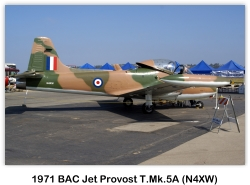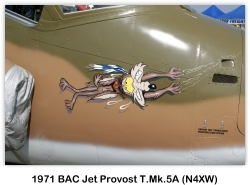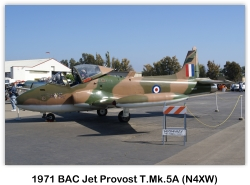
| ||||
|---|---|---|---|---|
 |
 |
 |
 |
 |



























| ||||
|---|---|---|---|---|
 |
 |
 |
 |
 |


























British Aircraft Jet Provost T.Mk.5A
British Military Trainer Aircraft
Archive Photos
BAC Jet Provost T.Mk.5A (XW323) c.1994 at the Royal Air Force Museum London, Hendon Aerodrome, London, England

British Aircraft BAC P.84 "Jet Provost" T.Mk.5A (N4XW/XW435, c/n EEP/JP/1057) at the 2007 & 2008 Camarillo Air Show, Camarillo, California








Overview 2
The BAC Jet Provost (originally built by Hunting Percival) was a British jet-powered trainer aircraft used by the Royal Air Force (RAF) from 1955 to 1993.
The BAC Jet Provost is a British jet trainer aircraft that was in use with the Royal Air Force (RAF) from 1955 to 1993. It was originally developed by Hunting Percival from the earlier piston engine-powered Percival Provost basic trainer, and later produced by the British Aircraft Corporation (BAC). In addition to the multiple RAF orders, the Jet Provost, sometimes with light armament, was exported to many air forces worldwide. The design was also further developed into a more heavily armed ground attack variant under the name BAC Strikemaster.
Development 2
In early 1951, Hunting Percival began work on the design studies that would ultimately lead to the Jet Provost. At the time, the company in the process of establishing mass production for the earlier piston-engined Percival Provost basic trainer, but had anticipated that demand for a jet-powered trainer aircraft would be on the horizon. The design team aimed to produce an aircraft capable of equaling the handling characteristics of operational jet fighters of the era while also possessing modest approach and stall speeds and remaining simple to handle, as opposed to aiming to obtain maximum performance.
During the early design process, a series of increasingly frequent liaisons with RAF Flying Training Command took place, helping to gauge the considerations required to succeed in aspects of the proposed aircraft’s design, such as instructional processes and maintenance requirements. During development, Hunting Percival had intentionally reused as many existing components and subsystems of the Percival Provost as possible, including the tail surfaces, main planes and main undercarriage legs, to speed development through to the prototype stage. The initial design work was performed as a private venture, independent of any service requirement; in March 1953, sponsorship from the British Government to support the development was made available as a result of interest from the Ministry of Supply. That same month, an order for service-test quantity of Jet Provosts was received.
On 16 June 1954, the prototype XD674 conducted its maiden flight from the factory at Luton Airport, flown by Dick Wheldon. A series of seven flights were flown in quick succession over the following three days. By early November 1954, a total of 123 flying hours had been accumulated by the prototype during Hunting Percival’s own flight test program, after which the prototype was submitted for official trials at RAF Boscombe Down. While testing proved the overall performance of the Jet Provost to be satisfactory, refinements such as shortening the legs of the landing gear for a smoother ride when deployed at semi-prepared airstrips.
On 19 February 1955, the first of ten pre-production aircraft, designated as the Jet Provost T1, performed its first flight. In May 1955, three of the pre-production aircraft were assigned for the first stage of service trials with the Central Flying School (CFS) of the RAF to determine the value of the Jet Provost in the ab initio training role and to develop a syllabus for the training program. During the second stage of CFS trials using the same three aircraft, actual students were introduced to the type for practical evaluation purposes, which was performed at RAF Hullavington until the successful completion of trials on 2 July 1956. According to feedback from CFS examiners, the Jet Provost had noticeably improved the performance of students during its trial deployment.
As a result of the results and responses produced from the trials performed using the pre-production aircraft, Hunting Percival proceeded to develop and incorporate several different improvements upon the design. Amongst the changes made was an overall smoothening of the fuselage lines, hydraulic systems being substituted for pneumatic counterparts, and the addition of a dorsal fillet; the new model was designated as the Jet Provost T2. On 1 September 1955, the first Jet Provost T2 made its first flight. This variant was used only for development work; in addition to seeing use at Hullavington, three Jet Provost T2s were dispatched overseas for winterization trials in Scandinavia and a series of sales tours across Europe, Canada, the United States of America, and Latin America.
In June 1957, a production order was placed for the first 40 of the developed Jet Provost T3, featuring a more powerful Armstrong Siddeley Viper jet engine, ejector seats, a redesign of the airframe, and a shortened and strengthened version of the retractable tricycle undercarriage. Percival built a single example, which was used purely for structural tests throughout the development stages, giving the designers valuable research into what could be achieved with the basic design. On 22 June 1958, the first Jet Provost T.3 conducted its first flight. In total, 201 T3s were delivered between 1958 and 1962.
The T4 followed in 1960, fitted with a more powerful variant of the Viper engine and first flown on 15 July, and this was followed by the pressurised T5 in 1967. The T51 was an armed export version, sold to Ceylon ( present day Sri Lanka), Kuwait and Sudan. It was armed with two 7.7-mm (0.303-inch) machine guns. The T52 was another export version sold to Iraq, South Yemen, Sudan and Venezuela, with the same armament as the T51. The T55 was the final armed export version which was sold to Sudan. A more heavily armed variant of the airframe was developed as the BAC Strikemaster.
Design 2
The BAC Jet Provost is a dedicated jet-powered trainer aircraft; according to aviation publication Flight International, it has the distinction of being the first ab initio jet trainer to be standardized by any air force. As designed, it was intended for the Jet Provost to replace, rather than accompany, the use of piston-engine trainer aircraft. The Jet Provost incorporates numerous features to support students during training. The aerodynamic design deliberately avoids speed, instead focusing on favorable handling characteristics and ease of recovery from stall and spin conditions. An emphasis was placed on flexibility, enabling use of the type throughout a range of training operations.
The cockpit of the Jet Provost, and much of the operational equipment fittings, is essentially identical to that of the preceding Percival Provost. It features a side-by-side seating arrangement, both positions being fitted with duplicated flight controls and instrumentation, which is well suited to the pupil-instructor pairing. The dual flight controls employs conventional manually-controlled flight control surfaces via a cable-and-tie rod arrangement. A key feature for the era amongst the fittings in the cockpit is the Centralized Warning Panel, which alerts the pilots in the event of a number of unfavorable or hazardous conditions being detected, such as icing conditions, fire, and oxygen failure. The high-flying capabilities of the Jet Provost necessitated the addition of an oxygen system in the cockpit, which was unpressurized on early production aircraft.
The Jet Provost has an uncomplicated structure, the airframe being based on the Percival Provost, albeit being strengthened in key areas such as the main wing spar and featuring a substantially different undercarriage arrangement. It possesses an all-metal stressed-skin fuselage built in two sections, the forward section stretching from the rear of the engine bay to the nose comprises a double-frame to absorb the wing and engine loads, while the rear fuselage section uses an orthodox semi-monocoque structure. Major loads across the fuselage are supported by a combination of four longerons and a single longitudinal beam across the upper-center line. The ailerons, elevators, and rudder are all attached to the airframe via two inset hinges each. The nose contains a hinged metal assembly, housing the radio, batteries, and other electronic equipment, and is easily serviceable by ground crew. All fuel tankage is housed within the wings. Where possible, all components used were designed to maximized interchangeability and to conform with international standardization; a total of 49 service panels across the aircraft’s exterior provides access for maintenance and servicing.
The Jet Provost is equipped with a single Armstrong Siddeley Viper 101 turbojet engine, which is mounted behind the cockpit in a roomy stainless steel-lined engine bay upon a secondary steel-tube structure. Air is fed to the engine by a pair of ram-air intakes set on either side of the aircraft’s forward fuselage connected via sharply-curving ducts to converge just forward of the engine itself. As supplied, each engine is delivered as a compact engine-change unit, comprising the engine itself, accessories, and oil tank. Both the hydraulic and electrical systems were driven via a fuselage-mounted accessories gearbox connected to the Viper engine by a telescopic drive. One particular favorable aspect of the Viper engine is the low maintenance demands imposed for the era. Engine ignition is achieved via an electric starter system, the engine controls have been described as being of a conventional nature.
Operational Service 2
The Jet Provost proved to be a capable trainer. After successful acceptance trials of the T1 during late 1955 at No. 2 Flying Training School at RAF Hullavington, the RAF formally accepted the type in 1957. The first production version was the T3, powered by the Viper 102, and this entered service with No. 2 FTS, now relocated to RAF Syerston, during June 1959, when deliveries commenced from the Hunting Aircraft factory at Luton airport. The T3 was also operated by Central Flying School at RAF Little Rissington, the Royal Air Force College at RAF Cranwell,(in the 1970s Cranwell changed all of its T3 aircraft to T5a s ) Lincolnshire, and by No. 1 Flying Training School at RAF Linton-on-Ouse, Yorkshire, 3FTS at RAF Leeming, Yorkshire, 6FTS at RAF Acklington, Northumberland, and 7FTS at RAF Church Fenton, Yorkshire. The twin-seated side by side variant was also used at RAF Brawdy in Wales to train Forward air Controllers.
The later T4 was fitted with the more powerful Viper A.S.V. 11 of 2,500 lbs static thrust and first flew on 15 July 1960. It quickly entered service with the units listed above.
On 1 February 1960, a T51 variant operated by the Royal Ceylon Airforce (Now Sri Lanka Airforce) crashed into the Negombo Lagoon soon after takeoff due to engine burnout. The pilot, Noel Lokuge, ejected and survived becoming the first Sri Lankan pilot to eject and survive.
The T5 variant was further developed and fitted with the Viper 201 and cockpit pressurization. These developments encouraged the RAF to utilize the Jet Provost in a number of different roles besides basic training. With a top speed of 440 mph, excellent maneuverability, mechanical reliability and low operating costs, the Jet Provost was utilized as an aerobatic aircraft, air warfare and tactical weapons training as well as advanced training. The first T5 made its maiden flight on 28 February 1967 and deliveries from BAC’s Warton factory commenced on 3 September 1969. Operators of the T 5 included the RAFs Central Flying School and No. 1, No. 3 and No. 6 Flying Training Schools.
Besides service with the RAF, the Jet Provost found success in export markets. A single Jet Provost T2 was exported to Australia and was operated by the Royal Australian Air Force (RAAF) to evaluate the type for the purpose of providing ’all-through’ jet-based training. Following a six-month evaluation period, the RAAF ultimately decided to retain the de Havilland Vampire to fulfill its requirements for a jet-powered trainer, and later replaced its Vampires with the Italian-built Aermacchi MB-326 during the late 1960s instead. The sole aircraft itself was retained, being presented to the Sydney Technical College for use as an instructional airframe, and was later preserved.
The Jet Provost was withdrawn from RAF service during the early 1990s, having been replaced by the newer turboprop-powered Short Tucano. Ab initio training had reverted to piston-engined aircraft in the early 1970s, using the Scottish Aviation Bulldog.
The Jet Provost remains popular among private operators and enthusiasts; being an inexpensive jet, many have been acquired and maintained in a flightworthy condition by collectors and private individuals. Some are flown at airshows, whilst roughly equal numbers are maintained in ground-runnable condition at various locations, many of these being in the United Kingdom.
Variants 2
Operators 2
Specifications and Performance Data (Jet Provost T.Mk.5) 3
Fuselage:
Tail Unit
Landing Gear
Power Plant
Accommodation
Systems
Armament (optional)
Dimensions (external)
Areas
Weights
Max level speed
Rate of climb
Service ceiling
T-O Run
T-O to 50 ft (15 m)
Landing from 50 ft (15 m)
Landing run
Max range: with tip-tanks, at 160 knots (184 mph; 296 km/h) EAS at 35,000 ft (10,670 m) with 288 lb (130 kg) reserve fuel
References